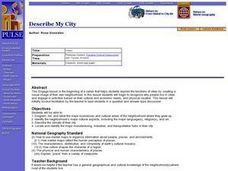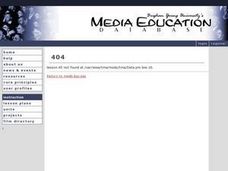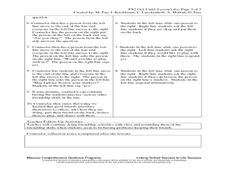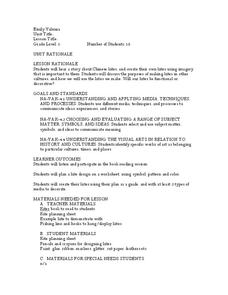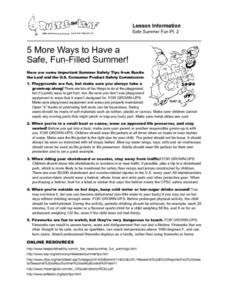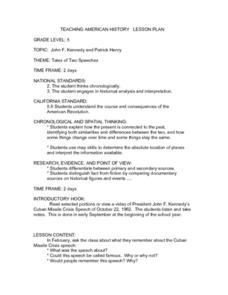Curated OER
Fort Hancock and the Sandy Hook Proving Ground Historical District
Students examine the history of the United Stated defending the coast line. They also analyze how military technology has changed the way the coasts are defended. They discuss how military expenditures have affected their community.
Curated OER
Springfield Digital Storytelling Project #6: Grapes Commercial
Here is a fabulous instructional activity that should have your class very excited! They utilize the GRAPES formula in order to produce a commercial like ones we see on TV. Working in pairs, they must come up with a script, take video,...
Curated OER
The Many Roles I Play in My Community
Second graders are asked: "What roles do people have in the community?" They view a large web on chart paper. Students discuss the roles that they play in their community. They are told that just as the principal or teacher has many...
Curated OER
Unearthing the Past
Students analyze artifacts from an early society to determine information relating to daily life in that society. They consider which artifacts from our society would be most valuable to future archeologists.
Curated OER
Describe My City
Students explore the functions of cities by creating a visual image of their own neighborhood. Students diagram, list, and label the major businesses and cultural areas of the neighborhood where they grew up, then write a letter to a...
Curated OER
Silly School vs. Super School
Students explore the importance of classroom jobs. They observe a puppet who is irresponsible and never gets her work completed and then discuss whether or not this puppet should be given a classroom job. As a class, they examine the...
Curated OER
Famous Faces of the American Revolution
Fifth graders research important people of the American Revolution. In this American Revolution lesson plan, 5th graders research political, economical, and military influences.
Curated OER
Current Earthquake Activity
Fifth graders record any earthquake activity throughout the school year on various maps. In groups, they identify a map locating the points given to them by their teacher. To end the instructional activity, they add the date, strength...
Curated OER
Name That Point!
Pupils compare projectile point attributes, identify and classify points, and match projectile points to a chronology.
Curated OER
Secondary Citizenship: The Importance of Volunteering
Eleventh graders define the word citizenship and explain what they think Dr. Langstaff meant by the question "Are you being a good citizen?" They are asked if they are active citizens. Students list acts they consider to be...
Curated OER
Family Tradition And History
Second graders investigate personal family traditions with objects brought to class that represent personal history. The objects are shared with the class during sharing time. The goal of the instructional activity is that students would...
Curated OER
Everyday Objects As Artwork
Young scholars examine everyday Chinese objects and analyze why they are
considered artwork today in this multi-subject lesson plan for Middle School. Small group colaboration is emphasized.
Curated OER
The High Cost of Chemical Dependency
Sixth graders explore, analyze and study the effect and impact that humans have on the environment based on their choices as individuals, businesses and governments. They assess the balance between human activities and aquatic pollution.
The New York Times
Collateral Damage? Researching a Connection Between Video Games and Violence
Hook your class into an exploration of and discussion about violence in video games with a cute animal clip and a video game trailer. After a quick discussion about how media can affect mood, class members read a related article and...
Curated OER
History of American Child Labor
Students study the historical and social issue of child labor. They examine the photographs of Lewis Hine to see evidence of child labor and decide how the photographs depict the historical impact of the practice. They write a letter to...
Curated OER
Phenomenology Lesson Plan #5: Character Part 2
Students examine the meaning of the word icon as it relates to media and pop culture. They watch and discuss film clips, write a mini-biography, take a Film Icon Quote quiz, and write a written response to the film clips.
Curated OER
Friendship Line Dancing
First graders explore the characteristics of being a good friend. They observe a puppet and discuss why the puppet is sad. In groups, 1st graders form two lines, facing each other. They practice talking to each person in the line,...
Curated OER
Digging Up Facts
Students research a historical legend. They participate in a discussion of the legend of Kissing Kate Barlow in the novel Holes. Students then chose one of three American legends and use internet research to complete a provided graphic...
Curated OER
Chinese Kites
First graders investigate the concept of kite making in the culture of China. They design and create their own kites. The purposes of making kites is discussed and the question of a kite's functionality is covered.
Curated OER
Sending Messages, Then and Now
Students analyze how patriots created ways to communicate during the Revolutionary War. After reading about and discussing ways patriots communicated, students create a chart analyzing the way messages are sent today with the way...
Curated OER
Life of a Logger
Learners are introduced to the work and lives of 19th century lumberjacks through a living history slide show presentation. They compare and contrast life 150 years ago with the present. Students describe the history of logging in...
Curated OER
5 More Ways to Have a Safe, Fun-Filled Summer!
Students review and discuss five important summer safety tips.
Curated OER
Using Fairy Tales to Promote Retention of Ethical Standards
Students explore ethical systems. Students read fairy tales and Bible stories to identify examples of ethical systems. Students brainstorm and discuss movies, songs and poems that exemplify ethical system.
Curated OER
Tale of Two Speeches
Students view and read portions of John F. Kennedy's Cuban Missile Crisis speech from October 22, 1962. Later in the year, students recall what they remember about the speech and use a Venn Diagram to compare it to Patrick Henry's...






